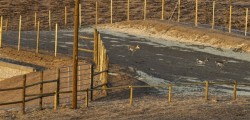News & Media
Wyoming: Where The Deer And The Antelope Play In An Overpass (At Last)
The best reasons to allow hunting in animal-heavy states are that they get hit by cars a lot and they starve. When it comes to cars, some areas are going to be a lot more dangerous than others and it is not a question of how many animals are there but simply where the road is. They have done things their way for 6,000 years and don’t want to change, regardless of what automobiles might like.
But the animals will go over. Case in point: The Wildlife Conservation Society (WCS) has announced the successful use of newly constructed overpasses that provide safe passage for thousands of migrating pronghorn over U.S. Highway 191 in Trapper’s Point, Wyoming, and surrounding areas.
Pronghorn are North America’s fastest land animals and number about 700,000 today, with more than half of those in Wyoming. The animals migrate to find food, mating opportunities and suitable habitat in order to survive.
WCS has long studied an approximately 93-mile (150 km) migration of pronghorn between wintering grounds in the Upper Green River Basin and summering grounds in Grand Teton National Park — a migration corridor known as the “Path of the Pronghorn.” They travel farther than the others and their continued journeys to and from Grand Teton ensure that the park’s ecosystem remains ecologically whole and that a 6,000 year-old migration remains a part of our national heritage.
WCS worked with many partners, including Grand Teton and Bridger-Teton National Forest, to bring about the designation of the Path as the first and only federally designated migration corridor in the United States. The locations of the structures completed this fall were informed by data collected by WCS, the Wyoming Cooperative Fish and Wildlife Research Unit, and the Wyoming Game and Fish Department, and identified the pronghorn’s preferred migration routes and highway crossing points.
As part of their research, WCS scientists used GPS tracking collars to collect information over the course of five years on the location and timing of pronghorn movements and impediments to migration such as fences, roadways, pipelines, and other energy development infrastructure.
Using this information, the Wyoming Department of Transportation (WYDOT) was able to locate and build the structures as part of an effort to protect motorists and provide safe passage for migrating pronghorn and other wildlife in the Greater Yellowstone Ecosystem. Trapper’s Point has historically been a “bottleneck” problem area for the pronghorn each year, causing thousands of the animals to cross traffic lanes on U.S. Highway 191, and creating a perilous situation for humans and wildlife alike.

The overpass at Trapper’s Point is one of eight safe passages constructed by WYDOT along a 13-mile stretch of highway. In addition, eight-foot high barrier fencing has been placed along the highway to channel the animals to the crossing points. In all, 2 overpasses and 6 underpasses have been constructed and will accommodate not only pronghorn, but also mule deer, moose , elk and other animals. The two overpass structures were specifically located and designed to address pronghorn migration conservation needs.
“The importance of these overpasses and their use by pronghorn cannot be overstated,” said WCS Conservation Scientist Joel Berger. “They eliminate the danger of collisions and will help to preserve a spectacular element of our natural heritage—the longest mammal migration in the 48 contiguous United States. This is an accomplishment that all Americans can celebrate.”
![ARC [diagram]](https://arc-solutions.org/wp-content/themes/arc/images/arc-diagram.jpg)
